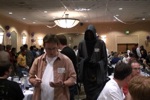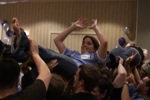


| Home |
| Overview |
| The Handbook |
| The Trading Game |
| Applications |
| The Release Party |
| The Route |
| The Clues |
| Results |
| Pictures |
| Pre-game website |
On Friday night, teams arrived for dinner around 6:00, found their seats and proceeded to laboriously discover that there were no puzzles in the dining room. Needless to say, the beautiful hand-made centerpieces received a lot of scrutiny and we appreciate players being discrete as they were dismantling them. All of the players were also given name badges, each of which contained a pseudonym--previously chosen by the player--and a three-digit number. The numbers came into play later in the evening, but some teams began collecting the data, just in case. Golden Nugget later confessed that they didn't believe there to be a puzzle, but they got out pads and pens and started writing furiously, just to mess with the other teams.
For the record, the best part of running a game is the power. As teams entered the dining room on Friday night, they were told "It is not necessarily in your best interest to sit with your team tonight." Afterwards, this showed up in one account as "No two members of the same crew are allowed to sit at the same table." If GC suggests that it might be a good idea to do something, you better believe they'll do it. It is a power to be used only for good, never for evil. Well, almost never.
So how do you get a roomful of puzzle geeks to mingle? You award points. The trading game aspect of this event was intended to be very social. While teams didn't know this yet, we wanted to emphasize the interactive spirit of our game right from the beginning. Intimating that maybe sitting with other people during dinner might possibly be to their advantage (potentially) was step one.
Step two was the entertainment. After dinner, one wall of the dining room was removed to reveal a room full of activities. Along one wall was a par 10 tiddly wink golf hole on which teams would play a best-wink scramble. In the corner was a podium at which teams would have to think of songs with particular words in them and sing. The other corner held the trivia challenge, where teams competed to answer the most science fiction-themed trivia questions. In the middle, teams were invited to perform various feats of dexterity with toy plastic gripping arms. Across the hall was a charades challenge, in which players would have to charade words across a video feed to guessers in the next room. There was also a team scavenger hunt, in which groups of people could collect points just by sharing one of a set of predetermined characteristics (height, birthday, underwear color, as well as a variety of information we collected in a pre-game survey).
Most of these challenges required a group of four people to attempt, but of course there were a few rules. First of all, people from the same team could not cooperate on a challenge. Teams had to mix themselves up to participate. Second, no two players could work together more than once. Each player was issued a dance card that kept track of who they worked with through the night. Players were allowed to trade this dance card for a blank one once during the evening.
When a group of players successfully completed a challenge, they were issued a ticket. They could then bring this ticket to the scoring table where they could redeem it for information. All members of the group got the same information. The information was necessary for solving the six meta-puzzles of the event. Each meta-puzzle was simply a few sentences of text that were initially entirely unknown. The reward for completing a challenge was that a random selection of letters in the meta-puzzles were revealed to those players. They would then bring this information back to their teams and be one step closer to solving the metas.
Each meta-puzzle turned out to be a set of instructions for a physical feat that the team had to perform. No feat could be performed by a single team, so teams again had to pool information and work together. Each feat had a public component, which was performed for the whole room, and a private component that was verified by GC afterwards. For example, one feat involved passing two people mosh-style across the room and having them dismount into a hand-stand. Had they failed in the middle, another team could not have copied them, as they wouldn't know about the hand-stand. The other feats included a ten-person human pyramid (alternating rows facing different directions); ten people catching pennies off of their elbows in unison (pennies dated before 2000); twelve people sitting on each others' laps in a ring (arranged by age); stretching people across the room to connect two walls (and humming Row, Row, Row Your Boat in four-part round); and two people reciting a haiku while sitting in chairs hoisted to shoulder height (the two people alternating syllables).
After all of the feats had been accomplished; players gathered in the dining room again for a pre-game spiel before bed. This is when they learned about the overall structure of the game, including the trading game. As teams were leaving for their hotel rooms, they could be seen exchanging phone numbers in anticipation of the weekend negotiations.




